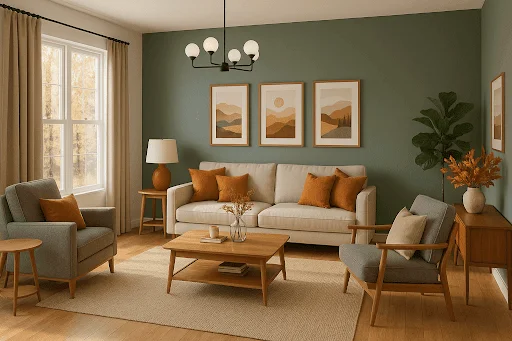Whether you live in a city apartment, a compact new-build, or a charming older home with quirky room dimensions, one challenge unites us all: the quest for more space. In the world of interior design, creating the feeling of spaciousness is one of the most requested and most satisfying transformations. It’s not about magic; it’s about smart, strategic design at Arcadium 3D.
For years, this process was a high-stakes guessing game. It involved tape measures, hopeful estimates, and the nerve-wracking moment of delivery when you discover the sofa you loved online completely swallows your living room.
This traditional approach is filled with friction, risk, and the potential for costly mistakes. A flat, 2D floor plan simply can’t convey the volume and scale of a real-world object, leaving you to bridge the “imagination gap” on your own.
But today, that’s all changed. A fundamental transformation in design technology has shifted the power from professional-grade software into the hands of everyone. We can now move beyond guesswork and step into a world of photorealistic visualization, where we can test, refine, and perfect our space-saving ideas with absolute confidence before committing to a single purchase.
Expand your knowledge with this handpicked companion read.
The Core Strategies for Maximizing Your Space
Smart space-saving design is built on a few key principles. Here’s how to implement them and how modern tools have made it easier than ever.
1. Embrace Multi-Functionality
In a small space, every piece of furniture should work hard. Multi-functional furniture is the cornerstone of smart design. Think of an ottoman with hidden storage, an expandable dining table that can host guests, or a stylish sofa bed that turns a living room into a guest room.
- The Old Way: Hoping the piece would fit and function without making the room feel cramped when in use.
- The Transformation: Using a 3d room design free or Arcadium 3D tool allows you to visualize the furniture in all its states. You can see exactly how much floor space that sofa bed will take up when extended or ensure you have enough clearance to walk around the dining table when all the leaves are in. This removes all risk and ensures your functional pieces are truly functional for your specific room.
2. Go Vertical
When floor space is limited, the only way to go is up. Utilizing vertical space is a classic designer trick. Tall, narrow bookcases, floating wall shelves, and floor-to-ceiling wardrobes draw the eye upward, creating an illusion of height and providing ample storage without eating into your precious square footage.
- The Old Way: Trying to eyeball proportions and hoping a tall unit wouldn’t feel top-heavy or overwhelming.
- The Transformation: A 3D planner or Arcadium 3D lets you place accurately scaled vertical elements into your virtual room. You can check sightlines and ensure the room still feels balanced and open, not like a canyon of furniture.
3. Master the Art of Illusion
Sometimes, making a room feel bigger is just as important as the physical space you create. Visual tricks can dramatically alter the perception of a room:
- Mirrors: Placing a large mirror opposite a window bounces light around and creates a sense of depth.
- Light Colors: Painting walls in light, neutral colors makes a space feel more airy and open.
- “Leggy” Furniture: Sofas, chairs, and tables with visible legs create a sense of openness because you can see the floor underneath them.
- The Old Way: Painting swatches on the wall and hoping for the best; buying a mirror without knowing its true impact.
- The Transformation: With a 3D tool, you can experiment with these illusions instantly. Test dozens of paint colors on your virtual walls, place a digital mirror, and swap out a bulky sofa for a more streamlined, leggy version to see the immediate effect on the room’s perceived size.
4. Zone Your Space
In open-plan layouts, it’s crucial to create defined “zones” for different activities. You can use a large area rug to anchor a living room seating area, arrange a console table behind a sofa to delineate a workspace, or use an open-backed bookshelf to create a visual separation without blocking light.
- The Old Way: A frustrating process of physically moving heavy furniture around until something “clicked.”
- The Transformation: This is where a 3D planner truly shines. You can drag and drop furniture, experiment with different rug sizes, and test various zoning configurations to perfect the room’s flow and function before you lift a single thing.
The Tool That Makes It All Possible: Arcadium 3D
While these strategies are effective, their success hinges on flawless execution. This is precisely the problem that Acradium 3d was built to solve. It’s an incredibly powerful yet intuitive platform that transforms the complex task of space planning into an easy and enjoyable creative process.
What makes it the perfect ally for space-saving design is how it directly addresses the biggest challenges:
- Certainty of Scale: The risk of buying furniture that’s too big is the number one fear in small-space design. Arcadium 3D’s vast library of furniture and decor is all built to precise, real-world scale. You can drop a sofa into your plan and know with 100% certainty how it will fit.
- Photorealistic Clarity: You aren’t just looking at blocky shapes. The platform’s AI-powered engine generates stunning, photorealistic renderings in seconds. This allows you to truly see how light will play in the room, how colors will feel, and whether your visual tricks are working.
- Effortless Experimentation: Because the tool is entirely online and incredibly fast, you can iterate endlessly without penalty. Try ten different layouts. Test twenty paint colors. Swap out every rug. This freedom to experiment is what leads to truly innovative and optimized design solutions.
- Intelligent Suggestions: For those moments when you’re truly stuck, the platform’s AI can analyze your space and generate multiple layout options for you, helping you discover possibilities you may have never considered.
Let’s be real: for most people looking to upgrade their kitchen for guests, the mind wanders toward natural stone countertops, high-end appliances and, perhaps, a little wine fridge, notes leading property management Cibolo TX, Limestone Properties. But here’s the thing that most people forget: the kitchen sinks. An upgraded kitchen sink isn’t just a sensible touch. It’s a surefire way to take home entertaining to the next level.
Design with Confidence, Not Compromise
Living in a smaller space doesn’t mean you have to compromise on style or function. It simply requires smarter planning. The days of guesswork, expensive mistakes, and design anxiety are over. The transformation in design technology has put the power of a professional studio right at your fingertips.
By leveraging smart strategies and embracing tools like Arcadium 3D, you can move from feeling limited by your space to feeling empowered by its potential. You can plan, visualize, and execute your ideas with confidence, creating a home that is not only beautiful and stylish but brilliantly designed to maximize every single inch.
Looking to expand your knowledge? Check out more of our articles!







